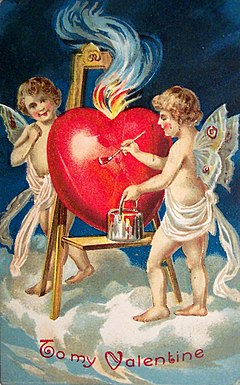St Valentine's Day, happens this Tuesday on February 14. It's a day where people show their love and affection for another person - usually in the form of cards, flowers, gifts and messages.
BRIEF HISTORY OF VALENTINE CELEBRATION
Valentine's Day, also called Saints Valentine's Day or the Feast of Saint Valentine, is an annual holiday celebrated on February 14. It originated as a Western Christian liturgical feast day honoring one or more early saints named Valentinus, and is recognized as a significant cultural and commercial celebration in many regions around the world, although it is not a public holiday in any country.
The day first became associated with romantic love within the circle of Geoffrey Chaucer in the 14th century, when the tradition of courtly love flourished. In 18th-century England, it evolved into an occasion in which lovers expressed their love for each other by presenting flowers, offering confectionery, and sending greeting cards (known as "valentines"). In Europe, Saint Valentine's Keys are given to lovers "as a romantic symbol and an invitation to unlock the giver’s heart", as well as to children, in order to ward off epilepsy (called Saint Valentine's Malady). Valentine's Day symbols that are used today include the heart-shaped outline, doves, and the figure of the winged Cupid. Since the 19th century, handwritten valentines have given way to mass-produced greeting cards.
February 14 is celebrated as St. Valentine's Day in various Christian denominations; it has, for example, the rank of 'commemoration' in the calendar of saints in the Anglican Communion.[8] In addition, the feast day of Saint Valentine is also given in the calendar of saints of the Lutheran Church.[9] However, in the 1969 revision of the Roman Catholic Calendar of Saints, the feast day of Saint Valentine on February 14 was removed from the General Roman Calendar and relegated to particular (local or even national) calendars for the following reason: "Though the memorial of Saint Valentine is ancient, it is left to particular calendars, since, apart from his name, nothing is known of Saint Valentine except that he was buried on the Via Flaminia on February 14."
The feast day is still celebrated in Balzan (Malta) where relics of the saint are claimed to be found, and also throughout the world by Traditionalist Catholics who follow the older, pre-Second Vatican Council calendar.
In the Eastern Orthodox Church, St. Valentine is recognized on July 6, in which Saint Valentine, the Roman presbyter, is honoured; in addition, the Eastern Orthodox Church observes the feast of Hieromartyr Valentine, Bishop of Interamna, on July 30.
BOX OF VALENTINE CHOCOLATES

Since the 19th century, handwritten notes have given way to mass-produced greeting cards. In the UK, just under half of the population spend money on their Valentines, and around £1.9 billion was spent in 2015 on cards, flowers, chocolates and other gifts. The mid-19th century Valentine's Day trade was a harbinger of further commercialized holidays in the United States to follow.
In the second half of the 20th century, the practice of exchanging cards was extended to all manner of gifts. Such gifts typically include roses, and chocolates packed in a red satin, heart-shaped box. In the 1980s, the diamond industry began to promote Valentine's Day as an occasion for giving jewelry.
The U.S. Greeting Card Association estimates that approximately 190 million valentines are sent each year in the US. Half of those valentines are given to family members other than husband or wife, usually to children. When the valentine-exchange cards made in school activities are included the figure goes up to 1 billion, and teachers become the people receiving the most valentines. The average valentine’s spending has increased every year in the U.S, from $108 a person in 2010 to $131 in 2013.
The rise of Internet popularity at the turn of the millennium is creating new traditions. Millions of people use, every year, digital means of creating and sending Valentine's Day greeting messages such as e-cards, love coupons or printable greeting cards. An estimated 15 million e-valentines were sent in 2010. Valentine's Day is considered by some to be a Hallmark holiday due to its commercialization.
In the modern era, liturgically, the Anglican Church has a service for St. Valentine's Day (the Feast of St. Valentine), which includes the optional rite of the renewal of marriage vows. In 2016, Catholic Bishops of England and Wales established a novena prayer "to support single people seeking a spouse ahead of St Valentine’s Day."
CELEBRATION AND STATUS WORLDWIDE
Valentine's Day customs developed in early modern England and spread throughout the Anglosphere in the 19th century. In the later 20th and early 21st centuries, these customs spread to other countries, but their effect has been more limited than those of Hallowe'en, or than aspects of Christmas, (such as Santa Claus).
Due to a concentrated marketing effort, Valentine's Day is celebrated in some East Asian countries with Chinese and South Koreans spending the most money on Valentine's gifts.


No comments:
Post a Comment